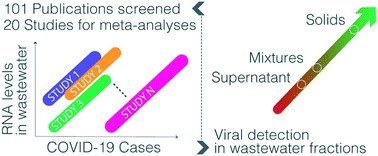Emerging investigator series: meta-analyses on SARS-CoV-2 viral RNA levels in wastewater and their correlations to epidemiological indicators†
Abstract
Background: recent applications of wastewater-based epidemiology (WBE) have demonstrated its ability to track the spread and dynamics of COVID-19 at the community level. Despite the growing body of research, quantitative synthesis of SARS-CoV-2 RNA levels in wastewater generated from studies across space and time using diverse methods has not been performed. Objective: the objective of this study is to examine the correlations between SARS-CoV-2 RNA levels in wastewater and epidemiological indicators across studies, stratified by key covariates in study methodologies. In addition, we examined the association of proportions of positive detections in wastewater samples and methodological covariates. Methods: we systematically searched the Web of Science for studies published by February 16th, 2021, performed a reproducible screening, and employed mixed-effects models to estimate the levels of SARS-CoV-2 viral RNA quantities in wastewater samples and their correlations to the case prevalence, the sampling mode (grab or composite sampling), and the wastewater fraction analyzed (i.e., solids, solid–supernatant mixtures, or supernatants/filtrates). Results: a hundred and one studies were found; twenty studies (671 biosamples and 1751 observations) were retained following a reproducible screening. The mean positivity across all studies was 0.68 (95%-CI, [0.52; 0.85]). The mean viral RNA abundance was 5244 marker copies per mL (95%-CI, [0; 16 432]). The Pearson correlation coefficients between the viral RNA levels and case prevalence were 0.28 (95%-CI, [0.01; 0.51]) for daily new cases or 0.29 (95%-CI, [−0.15; 0.73]) for cumulative cases. The fraction analyzed accounted for 12.4% of the variability in the percentage of positive detections, followed by the case prevalence (9.3% by daily new cases and 5.9% by cumulative cases) and sampling mode (0.6%). Among observations with positive detections, the fraction analyzed accounted for 56.0% of the variability in viral RNA levels, followed by the sampling mode (6.9%) and case prevalence (0.9% by daily new cases and 0.8% by cumulative cases). While the sampling mode and fraction analyzed both significantly correlated with the SARS-CoV-2 viral RNA levels, the magnitude of the increase in positive detection associated with the fraction analyzed was larger. The mixed-effects model treating studies as random effects and case prevalence as fixed effects accounted for over 90% of the variability in SARS-CoV-2 positive detections and viral RNA levels. Interpretations: positive pooled means and confidence intervals in the Pearson correlation coefficients between the SARS-CoV-2 viral RNA levels and case prevalence indicators provide quantitative evidence that reinforces the value of wastewater-based monitoring of COVID-19. Large heterogeneities among studies in proportions of positive detections, viral RNA levels, and Pearson correlation coefficients suggest a strong demand for methods to generate data accounting for cross-study heterogeneities and more detailed metadata reporting. Large variance was explained by the fraction analyzed, suggesting sample pre-processing and fractionation as a direction that needs to be prioritized in method standardization. Mixed-effects models accounting for study level variations provide a new perspective to synthesize data from multiple studies.

- This article is part of the themed collections: Emerging Investigator Series, Best Papers of 2022 from RSC’s Environmental Science journals, Recent Open Access Articles, Best Papers 2022 – Environmental Science: Water Research & Technology and Environmental Science – coronavirus research


 Please wait while we load your content...
Please wait while we load your content...